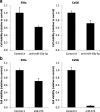Triage of high-risk HPV-positive women in population-based screening by miRNA expression analysis in cervical scrapes; a feasibility study
- PMID: 29930741
- PMCID: PMC5992707
- DOI: 10.1186/s13148-018-0509-9
Triage of high-risk HPV-positive women in population-based screening by miRNA expression analysis in cervical scrapes; a feasibility study
Abstract
Background: Primary testing for high-risk HPV (hrHPV) is increasingly implemented in cervical cancer screening programs. Many hrHPV-positive women, however, harbor clinically irrelevant infections, demanding additional disease markers to prevent over-referral and over-treatment. Most promising biomarkers reflect molecular events relevant to the disease process that can be measured objectively in small amounts of clinical material, such as miRNAs. We previously identified eight miRNAs with altered expression in cervical precancer and cancer due to either methylation-mediated silencing or chromosomal alterations. In this study, we evaluated the clinical value of these eight miRNAs on cervical scrapes to triage hrHPV-positive women in cervical screening.
Results: Expression levels of the eight candidate miRNAs in cervical tissue samples (n = 58) and hrHPV-positive cervical scrapes from a screening population (n = 187) and cancer patients (n = 38) were verified by quantitative RT-PCR. In tissue samples, all miRNAs were significantly differentially expressed (p < 0.05) between normal, high-grade precancerous lesions (CIN3), and/or cancer. Expression patterns detected in cervical tissue samples were reflected in cervical scrapes, with five miRNAs showing significantly differential expression between controls and women with CIN3 and cancer. Using logistic regression analysis, a miRNA classifier was built for optimal detection of CIN3 in hrHPV-positive cervical scrapes from the screening population and its performance was evaluated using leave-one-out cross-validation. This miRNA classifier consisted of miR-15b-5p and miR-375 and detected a major subset of CIN3 as well as all carcinomas at a specificity of 70%. The CIN3 detection rate was further improved by combining the two miRNAs with HPV16/18 genotyping. Interestingly, both miRNAs affected the viability of cervical cancer cells in vitro.
Conclusions: This study shows that miRNA expression analysis in cervical scrapes is feasible and enables the early detection of cervical cancer, thus underlining the potential of miRNA expression analysis for triage of hrHPV-positive women in cervical cancer screening.
Keywords: CIN; Cervical cancer; HPV; Scrape; Screening; Triage; miRNA; qRT-PCR.
Conflict of interest statement
This study was approved by the Institutional Review Boards of the VU University Medical Center and Antoni van Leeuwenhoek Hospital. All samples were used in an anonymous fashion in accordance with the “Code for Proper Secondary Use of Human Tissues in the Netherlands” as formulated by the Dutch Federation of Medical Scientific Organizations (https://www.federa.org) [47].DAMH occasionally serves on the scientific advisory board of Pfizer and Bristol-Meyer Squibb and has been on the speakers’ bureau of Qiagen. PJFS, RDMS, CJLMM, and DAMH are minority stakeholders of Self-screen B.V., a spin-off company of VU University Medical Center; and since September 2017, CJLMM is director of Self-screen B.V., which holds patents related to the work. PJFS has received speakers’ bureau honoraria from Roche, Qiagen, Gen-Probe, Abbott, and Seegene. He is consultant for Crucell Holland B.V. CJLMM has participated in the sponsored speaker’s bureau of Merck and Qiagen and served occasionally on the scientific advisory board of Qiagen and Merck. CJLMM owns a small number of shares of Qiagen, has occasionally been consultant for Qiagen, and until April 2016 was a minority shareholder of Diassay B.V. No potential conflicts of interest were disclosed by the other authors.Springer Nature remains neutral with regard to jurisdictional claims in published maps and institutional affiliations.
Figures




Similar articles
-
Complementarity between miRNA expression analysis and DNA methylation analysis in hrHPV-positive cervical scrapes for the detection of cervical disease.Epigenetics. 2019 Jun;14(6):558-567. doi: 10.1080/15592294.2019.1600390. Epub 2019 Apr 8. Epigenetics. 2019. PMID: 30955437 Free PMC article.
-
Defining hrHPV genotypes in cervical intraepithelial neoplasia by laser capture microdissection supports reflex triage of self-samples using HPV16/18 and FAM19A4/miR124-2 methylation.Gynecol Oncol. 2018 Nov;151(2):311-318. doi: 10.1016/j.ygyno.2018.09.006. Epub 2018 Sep 13. Gynecol Oncol. 2018. PMID: 30219239
-
DNA methylation marker for the triage of hrHPV positive women in cervical cancer screening: Real-world evidence in Taiwan.Gynecol Oncol. 2021 May;161(2):429-435. doi: 10.1016/j.ygyno.2021.02.011. Epub 2021 Mar 20. Gynecol Oncol. 2021. PMID: 33757653 Clinical Trial.
-
DNA methylation as a triage marker for colposcopy referral in HPV-based cervical cancer screening: a systematic review and meta-analysis.Clin Epigenetics. 2023 Aug 2;15(1):125. doi: 10.1186/s13148-023-01537-2. Clin Epigenetics. 2023. PMID: 37533074 Free PMC article.
-
Management of high-risk HPV-positive women for detection of cervical (pre)cancer.Expert Rev Mol Diagn. 2016 Sep;16(9):961-74. doi: 10.1080/14737159.2016.1217157. Epub 2016 Aug 5. Expert Rev Mol Diagn. 2016. PMID: 27459506 Review.
Cited by
-
LncRNA SNHG17 Contributes to the Progression of Cervical Cancer by Targeting microRNA-375-3p.Cancer Manag Res. 2021 Jun 23;13:4969-4978. doi: 10.2147/CMAR.S312469. eCollection 2021. Cancer Manag Res. 2021. PMID: 34188550 Free PMC article.
-
Complementarity between miRNA expression analysis and DNA methylation analysis in hrHPV-positive cervical scrapes for the detection of cervical disease.Epigenetics. 2019 Jun;14(6):558-567. doi: 10.1080/15592294.2019.1600390. Epub 2019 Apr 8. Epigenetics. 2019. PMID: 30955437 Free PMC article.
-
miR-9-5p Exerts a Dual Role in Cervical Cancer and Targets Transcription Factor TWIST1.Cells. 2019 Dec 26;9(1):65. doi: 10.3390/cells9010065. Cells. 2019. PMID: 31888045 Free PMC article.
-
Epigenetic and Transcriptomic Regulation Landscape in HPV+ Cancers: Biological and Clinical Implications.Front Genet. 2022 Jun 14;13:886613. doi: 10.3389/fgene.2022.886613. eCollection 2022. Front Genet. 2022. PMID: 35774512 Free PMC article. Review.
-
MicroRNA-Based Fingerprinting of Cervical Lesions and Cancer.J Clin Med. 2020 Nov 15;9(11):3668. doi: 10.3390/jcm9113668. J Clin Med. 2020. PMID: 33203149 Free PMC article. Review.
References
Publication types
MeSH terms
Substances
Grants and funding
LinkOut - more resources
Full Text Sources
Other Literature Sources
Medical

